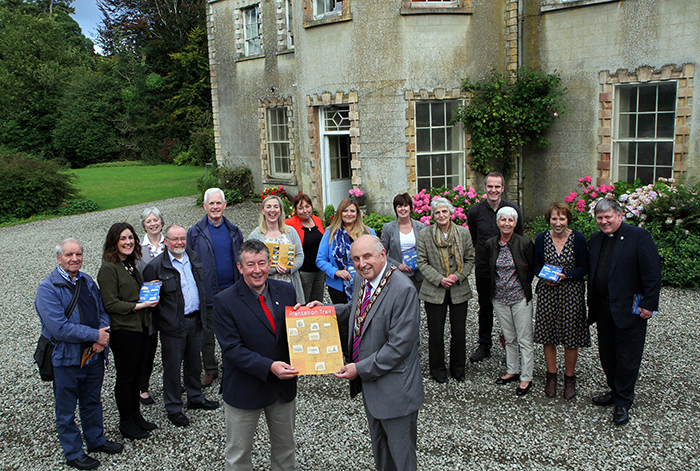 A NEW Plantation Villages and Houses Trail connecting some of Derry’s most historic sites, is expected to attract a fresh influx of visitors to the city and its rural hinterland following its official launch at the weekend.
A NEW Plantation Villages and Houses Trail connecting some of Derry’s most historic sites, is expected to attract a fresh influx of visitors to the city and its rural hinterland following its official launch at the weekend.
The Plantation Trail has been created by Foyle Civic Trust with the support of Derry City and Strabane District Council under the Rural Tourism Development Programme, and funding secured from the NGO Challenge Fund.
The Trail covers the rural areas around the city which were planted by the companies of the Goldsmiths, Grocers, Fishmongers and Skinners, including the villages of Eglinton and Claudy, the old churches and graveyards at Enagh and Cumber, and notable large houses dating from Plantation times.
Sites on the Trail include Enagh Lough (East) and Graveyard, Ashbrook House, Beech Hill House, Cumber Old Church and House, Learmount Castle, Prehen House, Boom Hall Site, and Culmore Fort.
Welcoming the initiative, the Mayor of Derry City and Strabane District, Councillor Elisha McCallion, encouraged visitors to discover the new Trail, which is aimed at enabling a better understanding of local history dating back to the early 1600s.
“A very helpful Rural Heritage Trail Map has been designed to highlight each of the eight sites featured as part of the project, which also includes Eglinton Village. Signage has been erected at the sites, which includes an overview of artefacts, family history, archaeological ruins and landscape.
“We believe the Trail will inspire our own local communities to learn more about the history of the city and its rural environs, as well as offering an exciting new tourism product for the many visitors who quite rightly regard Derry as a ‘must see’ destination.”
Jennifer O’Donnell, Council’s Rural Tourism Development Officer, said Council was delighted to work in partnership with Foyle Civic Trust to bring the project to fruition, with funding support from NGO Challenge Fund, which is administered by The Northern Ireland Environment Link on behalf of the Northern Ireland Environment Agency (NIEA).
She explained: “The Trail was developed to raise awareness of rural Derry’s Plantation history and to connect the Plantation villages and houses with the historic city and citadel of the Plantation Derry.
“The development of the Plantation Trail will enable a better understanding of local history and inspire community involvement.
“A map has been created in order to link the sites and inform people about the Plantation sites along the Trail. Interpretive signage has been placed at the sites in order to promote an understanding of the Plantation’s built and landscape heritage.”
Melanie Cunningham from Ashbrook House said: “We are very much looking forward to the new signage which we’re hoping will generate additional tourism not only in the city but in the surrounding rural area, especially the stunning Faughan Valley.
“Anything that puts Derry on the map and helps people discover its built heritage is positive news for everybody.”
Caroline Dickson, the Foyle Civic Trust Committee member responsible for the project with Derry City and Strabane District Council, said: “Foyle Civic Trust has been delighted to be associated with Derry City and Strabane District Council in implementing this project which, with the aid of its Trail Map, will encourage people to explore the surrounding areas of Derry and learn about the heritage of its villages, buildings and old graveyards.”
The official launch of the Plantation Villages and Houses Trail will take place on Friday, September 18th, at Ashbrook House.
Copies of the Trail pinpointing the various sites are available to download from…. You can also pick up a copy from the Council offices, local tourism outlets and other public buildings in the city and district.
The sites at a glance….
Enagh Lough (East) and Graveyard
The ruined church was probably founded in the 6th Century; the surrounding graveyard has many interesting inscribed headstones dating from the 17th Century. The island in the centre of the Lough was originally a Crannog.
Ashbrook House
One of the oldest Houses in the country. The oldest part was built by General John Ash from Devon in the 1590s. The front part of the house was added in 1760 by Sir Thomas Ash. Descendants of the Ash family still live in the house.
Beech Hill House
The original house was built in 1622 by Alexander Skipton, The present House was built in 1729 by Thomas Skipton and was named Beech Hill by him. Greatly enlarged in the 19th Century, the house is now a manor house hotel.
Cumber Old Church and House
The village of Claudy grew up around the estate of Cumber House. The adjoining church and graveyard are said to date from the time of St Patrick.
Learmount Castle
The first Plantation owners were the Skiptons of Beech Hill who obtained the lands in 1619. Later owners built the present house, incorporating the Plantation house as the east wing.
Prehen House
Ancestral house of the Knox family of the much famed Half Hanged McNaughton story. The Grade A listed house was built in 1745. There has been a house at Prehen since Plantation times.
Boom Hall site
Famous for its association with the boom across the Foyle during the siege of Derry.
Cumore Fort
The Fort guards the mouth of the River Foyle. Thought to have been built in the 16th Century, it was captured and recaptured several times during the Siege of Derry 1689.





